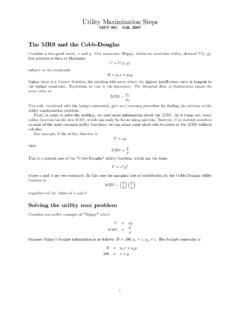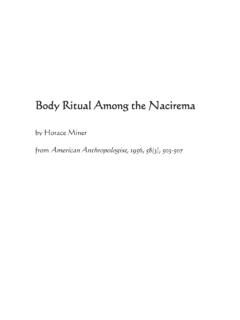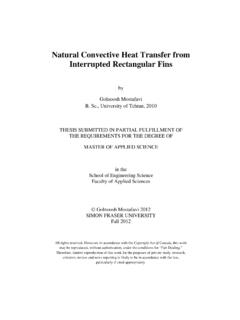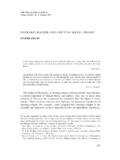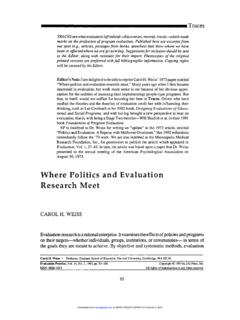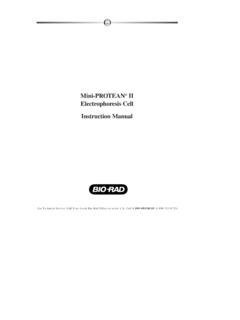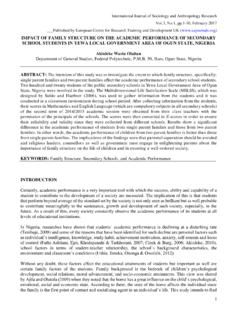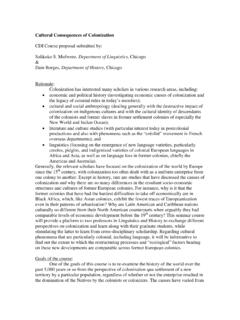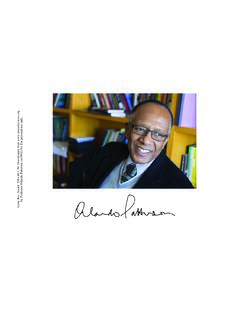Transcription of ETHNOGRAPHY AND PARTICIPANT OBSERVATION
1 17 ETHNOGRAPHY AND PARTICIPANT OBSERVATIONC hapter outline The origins of ETHNOGRAPHY Guidelines for fieldwork Gathering data: participative OBSERVATION and field notes Gathering data: interviewing Gathering data: digital media Ethical principles in ETHNOGRAPHY The ethnographic self Feminist ETHNOGRAPHY Critical ETHNOGRAPHY Sculpting the truth in ethnographic accounts Recording the miracleKeywords ETHNOGRAPHY PARTICIPANT OBSERVATION Fieldwork Reflexivity Natural settingsPRINTED BY: Ted Palys Printing is for personal, private use only. No part of this book may be reproduced or transmitted without publisher's prior permission. Violators will be Postmodernism Feminist ETHNOGRAPHY Critical ETHNOGRAPHY PositionalitiesChapter objectivesAfter reading this chapter you will be able to: Describe the origins of ETHNOGRAPHY as a data gathering method. Distinguish between ETHNOGRAPHY and structured observational methods.
2 Outline the circumstances when ETHNOGRAPHY is the most appropriate approach. Plan and conduct ethnographic fieldwork, selecting the field, gaining access, building rapport and getting out. Conduct ethnographic research ethically. Handle identity and know when and how to weave the self into ethnographic accounts. Write an ethnographic account that is authentic and is a qualitative research method that seeks to understand cultural phenomena that reflect the knowledge and meanings that guide the life of cultural groups within their own environment. While the origins of ETHNOGRAPHY lie in the socio - cultural anthropology of the nineteenth century, it is now widely used in sociology, communications studies, educational and medical research, and history subjects where the intention is to study people, ethnic groups and cultures. However, ETHNOGRAPHY remains a contested and, in the view of Jordan and Yeomans (1995), an often loosely used term.
3 Hammersley and Atkinson (2007: 1) see ETHNOGRAPHY as:.. a particular method or sets of methods. In its most characteristic form it involves the ethnographer participating, overtly or covertly, in people s lives for an extended period of time, watching what happens, listening to what is said, asking Willis and Trondman (2000: 5) it a family of methods involving sustained social contact with agents, and richly writing up the encounter, respecting, recording, representing at least partly in its own terms, the irreducibility of human , then, as PARTICIPANT observers, look at and record people s way of life and take an emic (folk or inside) and etic (analytic or outside) approach to describing communities and cultures. The research is carried out in natural settings and is sympathetic to those settings. Traditionally those involved in ethnographic research spend long periods of time in the place of study, and are able to produce thick written cultural descriptions that communicate the information found in the field, or, in the words of Fetterman (2010: 1) a credible, rigorous and authentic story.
4 While in the past, ethnographers may have travelled to distant places to study exotic tribes or groups, contemporary ETHNOGRAPHY can concern PRINTED BY: Ted Palys Printing is for personal, private use only. No part of this book may be reproduced or transmitted without publisher's prior permission. Violators will be with more mundane locations such as shopping malls, libraries, parks, workplaces, households, communities, cities and even information systems and The old and the new both are legitimate sites for ethnographyEthnographic accounts seek to be both descriptive and interpretive. Description is important because a high level of detail is essential. Interpretation is equally important because the ethnographer must determine the significance of what he or she observes. Ethnographic research typically employs three kinds of data collection methods: OBSERVATION , interviews and documents, often employing all three methods in a single study.
5 These in turn produce three kinds of data: quotations, descriptions and excerpts of documents. The aim of ethnographic research is to produce narrative descriptions that help to tell the story (Hammersley, 1990). Ethnographic methods can help in the development of constructs, themes or variables, but ETHNOGRAPHY is also used to test theory. Indeed no study, ethnographic or otherwise, can be conducted without recourse to theory whether scholarly or personal (Fetterman, 2010).One of the key decisions at an early stage is the extent to which the researcher is going to be a PARTICIPANT in the study, which can vary from complete immersion alongside those being observed, or complete detachment (or at least an attempt at detachment) with the role of spectator. Participation helps the researcher to develop an insider s perspective on what is happening. However, the researcher must also observe what is happening (whilst reflecting on their own involvement and biases).
6 The key to ethnographic research, then, is skilfully combining the role of PARTICIPANT and ORIGINS OF ETHNOGRAPHYThe origins of ETHNOGRAPHY are often attributed to the pioneering fieldwork of Polish anthropologist Bronislaw Malinowski. Published in 1914, in his seminal work, The Argonauts of the Western Pacific, Malinowski devotes a whole section of the book to explaining the process of gathering data through meticulously documented observations and interviews. He explained that, to have a thorough understanding of a different culture, anthropologists must have daily contact with their informants and become immersed in the culture which they are studying. The goal, then, PRINTED BY: Ted Palys Printing is for personal, private use only. No part of this book may be reproduced or transmitted without publisher's prior permission. Violators will be to understand the native s point of view.
7 To achieve this, not only must the anthropologist collect data, there needs to be an emphasis on interpretation. The link between data collection and the writing of ethnographic monographs is meticulous field notes. According to Roldan (2002), Malinowski increased the validity of his ETHNOGRAPHY by including in the text fieldwork data, information about the research process and theoretical its origins lie in the field of anthropology , ETHNOGRAPHY was soon taken up by sociologists, a move pioneered by the Chicago School at the University of Chicago in the 1920s, 1930s and 1940s. The primary assumption for the Chicago School was that qualitative methodologies, especially those used in naturalistic OBSERVATION (such as ETHNOGRAPHY ), were best suited for the study of urban, social phenomena. It was through the Chicago School that ETHNOGRAPHY and symbolic interactionism became closely associated.
8 The phrase symbolic interactionism was first coined in 1937 by Blumer (1969), although the approach to social analysis is largely credited to the work of George Hubert Mead during his time at the University of Chicago. Blumer (1969) argued that, in essence, humans act towards things (including fellow humans) according to subjectively attributed meanings which are interpreted reflexively and subjectively. The combination of ETHNOGRAPHY and symbolic interactionism led to the writing of several classic texts such as Whyte s Street Corner Society (1943) and E. Goffman s Asylums (1961). Ironically, the teaching of fieldwork methods at the University of Chicago was limited, with ways of organizing ethnographic research being largely acquired on the hoof (Shaffir, 1999).In recent years, ETHNOGRAPHY has witnessed great diversification with different approaches being adopted, guided by different epistemological concerns and ethnographic practice, including long-term in-depth studies, through to condensed fieldwork, consultancy work or participation in political struggles (Atkinson and Hammersley, 1994).
9 There has also been a growing application of ETHNOGRAPHY beyond anthropology and sociology into applied fields such as education, health and social policy. Sometimes associated with these more applied forms of ETHNOGRAPHY have been moves towards collaborative research, stemming not just from a desire for engagement with practice, but also from an epistemological concern that ETHNOGRAPHY has privileged the researcher as the implied Narrator over the Other, the object of the ethnographer s gaze. Hence, the accounts produced by researchers are viewed as constructions that reflect the presuppositions and the socio -historical conditions in which they were produced. Under the influence of various forms of antirealism such as constructivism (Guba, 1990) or poststructuralism (Denzin, 1990; Lather, 1991), claims for ethnographic accounts have become more sceptical. In the late 1980s and early 1990s, for example, a postmodern turn in anthropology challenged anthropologists to question their own assumptions and write more reflexively.
10 An example here is auto- ETHNOGRAPHY (Reed-Danahay, 1997) which has been encouraged by postmodern theory to draw out the narrative of PARTICIPANT OBSERVATION and relationships in the field through personal stories (of the researcher) as a reliable mode of expressing findings from the field (Coffey, 1999) and as a credible, adjunct data source (Possick, 2009).Anderson (1999: 456), however, is sceptical of what he terms the nihilist excesses of the postmodern turn, its hyper-reflexivity, and its clever, self-absorbed and evasive writing , serving to undermine empirical ethnographic work. He does, though, claim that some of its more positive insights will eventually be absorbed into what he calls analytic ETHNOGRAPHY , an empirical approach linked to ethnomethodological traditions. He is also optimistic about the future of ETHNOGRAPHY , pointing to the growth of ethnographic research in the 1990s, within a broader range of academic disciplines.
